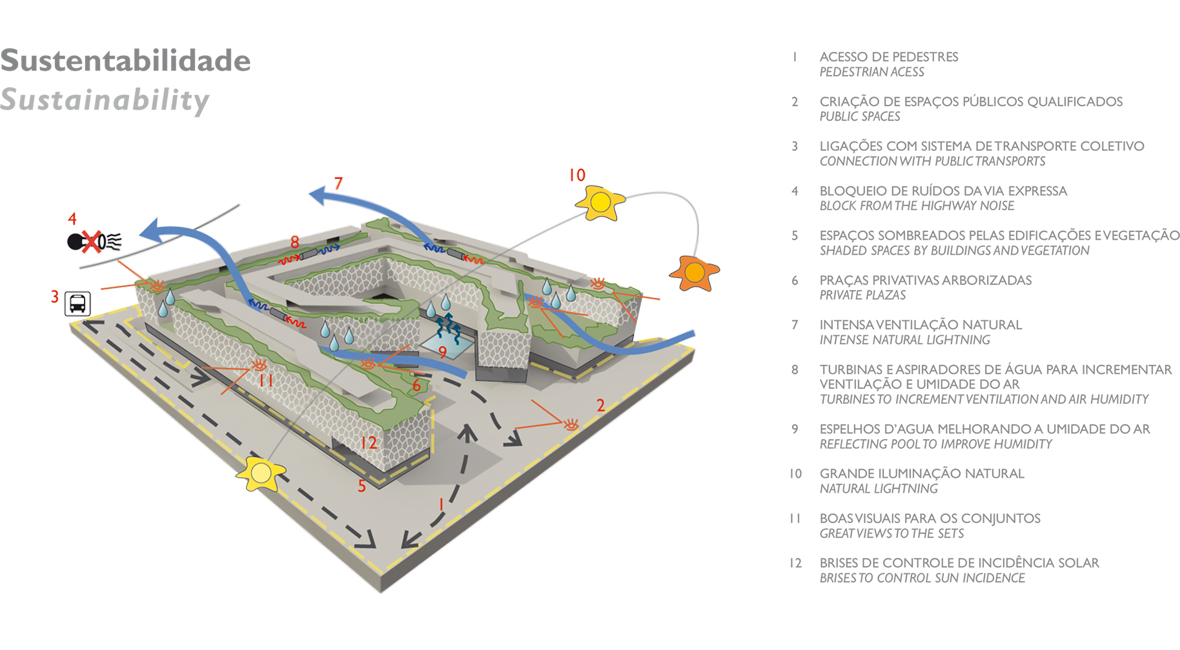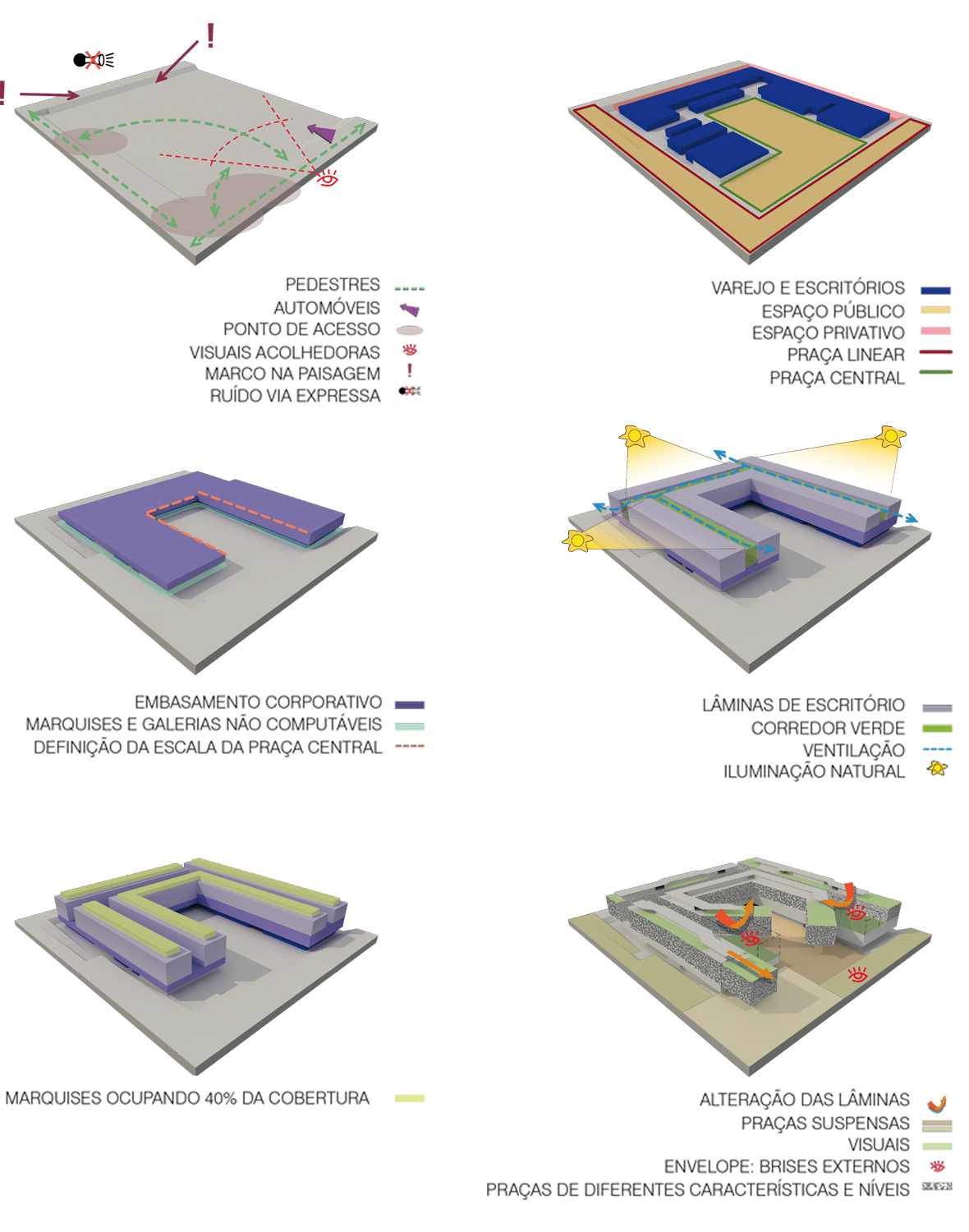Project Description
Sia Complex
Technical Data
Location: Brasília, DF – Brasil
Type of Construction: Commercial
Site area: 37.000 m²
Building area: 85.000 m²
Project Beginning: 2011
Team
Authors: Fernando Forte, Lourenço Gimenes, Rodrigo Marcondes Ferraz
Coordinators: Ana Paula Barbosa
Contributors: Carolina Matsumoto, Fábio Pittas, Marina Almeida, Juliana Nohara
Interns: Mayara Benegas
The multi-use complex proposed for this 32.000m² lot aims at creating not only a new architectural reference for the region, but also a new destination for the city. Adding three different uses – retail, office buildings and modular offices – the new complex creates a landmark in the landscape, values the surroundings, and establishes a new shopping destination.
With a daring design, it emphasizes the public and private open spaces, which are one of the main structural elements of the architectonic proposal. Thus, it is outlined as an attractive and seductive space, open for the local way and isolated from the expressway noise, able to attract pedestrians and drivers to get to know the beautiful square embraced by a building which corkscrews all around it. At the same time, a gradual system of permeability around the shops and living spaces takes advantage of an important flow of pedestrians, currently concentrated in the serving passage which connects the footbridge and the bus stops on the expressway to the activities of the local road, and enhances it.
In addition to the desired permeability and the configuration of a central square, the understanding of the three types of use, coupled with the interpretation of local law, is a determining factor for the geometry of the building. Rather than segregating them in weatherproof towers, it is exactly in the superposition of ‘layers’ of different features that the cohesion required for the complex is formed:
– the ground floor (semi-buried), designed mainly for commercial matters (retail), seeks a natural relation with the central square and serving spaces, now treated as an attractive linear square integrated into the set. Passage and permanence spaces, surrounded by Cafés, shops, restaurants and ice cream shops, set up a fluid space that always lead to the central square. Landings, pilotis, reflecting pools and green areas create a spatial diversity which provides a wide variety of uses. The anchors organize this space, create the main visual focus, and are distributed in order to generate movement among the smaller shops. The anchors and shops of the eastern flank, closer to the serving square, may be more focused on the most popular public profile, which moves between the public transportation and a local way. Yet, the southern and western shops may be more oriented to users and visitors of the own complex, besides serving outsiders who consider those shops as their final destination. In these two flanks, two anchor-shops, food court and modular shops open onto the central square, while their external perimeter, facing setbacks and with no movement of pedestrians, is occupied by offices with covered terrace and private garden. Six gatehouses, integrated into the square and the shops, give controlled access to the elevators which lead to the corporate and office floors;
– foundation: this layer stands out as a solid object on the ground floor space, in contrast with the fluidity and opening of the galleries which define it. These are the corporate spaces, here arranged in a linear way and concentrated on a large flagstone of 16.515 m² and a mezzanine of 2.629 m². Unlike superposing standard corporate flagstones, the intention was to create the greatest diversity of spatial arrangements possible, allowing leasing it to a single company or companies with different needs. With plentiful illumination and landscape facing the central square, the foundation sets the platform on which the office buildings and an amazing suspended square will be supported. From this, a part will have exclusive use of the corporate flagstone, serving as an outdoor space for lunch and rest for the staff, decompression area, pergolas for informal meetings on nice days, etc.
– office buildings: the need for illumination and ventilation for many small and medium sets implied in the creation of slender strips with two façades and central circulation. These volumes, with an average distance of 10m to 12m, create offices with two main features: those facing ‘out’, i.e., to the central square and the limits of the land, and those facing ‘in’. These latter, instead of having an unpleasant view, count on the existence of a green space that accompanies the two strips, opening up from time to time for the landscape and defining green perspectives for these sets. The tension created by the rupture of a more rigid parallelism, combined with more violent inflections over the central square, marks an always dynamic landscape, in order to avoid monotony. Result of the inflections of the volumes on the central square, the green corridor widens at the ends of the building, allowing a glimpse of this rich suspended garden. The perception will be of a great continuous garden, but these are private spaces of the sets that open to it, in order to make them more attractive and allow the sales of spaces that would normally be lost in another sort of conventional venture. These floors feature modular sets of different sizes, with and without garden or mezzanine, in order to accommodate businesses and professionals of different characteristics and ensuring the diversity which will encourage the efficiency of retail on the ground floor, as well as the intended uses for the top floor. In addition, the supply of different typologies favors the liquidity of the venture. Despite having a reading of continuity, the office buildings were designed with a certain independence between the parts that compose it, to allow the construction in stages and the phased launching, if needed;
– top floor: by turning to a breach of the legislation, it is possible to create a top floor for leisure and cultural uses up to the limit of 40% of the top floor with computable areas. Therefore, the proposal contemplates the use of these spaces for recreational uses such as gym, music or language schools, most exclusive restaurants (other than those referred to the food court on the ground floor), besides auditoriums and cultural centers of large companies, eventually with access controls and exclusive elevators for these spaces. The indoor spaces are surrounded by covered terraces and uncovered gardens, towards the creation of attractive spaces which are compatible with the nature of the intended uses. The use of these spaces allows for the extension of the characteristic hours of use of the complex, expanding the synergy between complementary uses (retail and parking) and attracting users from out of the complex. The importance of using the top floor as computable area is reflected in a better proportion of volume built over the open space on the ground floor, which stands out in the project.
The proposed architectonic start-up induces to a use of private areas much above the customer expectation only possible by a design which integrates, with high quality, internal and external areas. The private area is about 8% more superior than the computable area, which means a very interesting performance and proves that good architecture also brings good economical results. Besides the start-up, they turned to strategies allowed by the work code which emphasizes the gain of private area, and allows a greater release of the ground floor for public space. One of them is the use of the semi-buried floors and the top floor, which allows the creation of two additional floors without infringing the legal limit. This possibility, besides favoring the desired open space, turns to the natural slope of the land to create access to one of the anchor-shops at two different levels, ensuring public spaces always guarded by the activities of the complex. The marquees and galleries on the ground floor, in addition to providing a shaded area of transition between inside and outside areas, culturally widespread example in Brasília, were used as non-computable areas.
Architecture already forecasts, in a conditioned way to its own design, a superior performance in terms of sustainability, which can be translated into energy efficiency, water management, hygrothermal comfort and relation with the city. Some elements are obvious, such as metallic brise-soleil which envelops the office blades when necessary; the reflecting water pools which cool and humidify Brasilia’s dry air passively through its natural evaporation; the vegetation of several levels, guaranteeing a lower atmospheric temperature range, besides a more enjoyable landscape and better thermal insulation of the covering flagstones; or the implementation that takes advantage of the availability of public transportation and offers the city a generous space for everyone as a gift. And there are also the less obvious elements that will be part of more detailed analysis throughout the development of the project, e.g. integrated systems and higher performance materials: water sprinklers and ventilation turbines provided over the suspended gardens, thermal insulation systems, recyclable materials or complementary systems of renewable energy are some possible examples.

Sustainability

Diagrams
